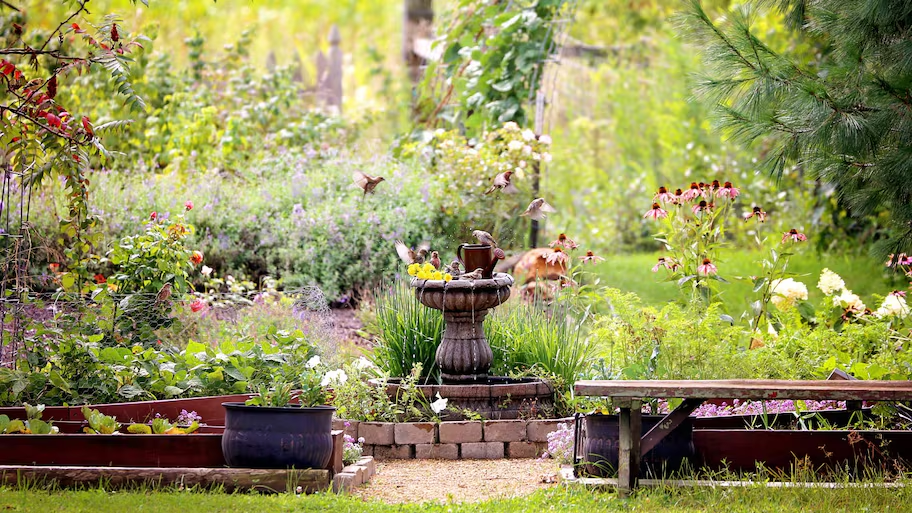Creating a backyard haven for wildlife through gardening involves more than just planting flowers; consider incorporating native plants to attract local species, provide food and shelter, and minimize pesticide use to maintain a healthy ecosystem. Additionally, features like bird feeders, birdbaths and nesting boxes can enhance the habitat for various creatures
Do you know what are the attractive sides of gardening for wildlife?
01) Bringing Nature Closer
Creating a wildlife-friendly garden allows you to bring a piece of the nature world closer to your home. It provides opportunities to observe and interact with a diverse array of wildlife species right in your own backyard.
02) Sounds of Nature
The presence of wildlife in your garden brings with it the soothing sounds of birdsong, buzzing insects, and rustling leaves, enhancing the sensory experience of spending time outdoors.
03) Colorful vibrant Landscapes
Wildlife gardens are often filled with colorful flowers, foliage, and visiting birds and butterflies, creating visually stunning and dynamic landscapes that change with the seasons.
04) Photography & Art opportunities
Wildlife gardens provide excellent opportunities for photography and artistic expression. Capturing images of birds, butterflies and other creatures can inspire creativity and appreciation for the natural world.
05) Creating Memories
Gardening for wildlife creates opportunities to make lasting memories with family and friends.
Come !!! Let's create a backyard haven.
- Research Native Species.
- Plant Diversity
- Provide water
- Create habitat layers
- Reduce chemical use
- Add wildlife features.
- Maintain year-round interest
- create Shelter
- Regular maintenance
- Observe and learn
Unique, interesting aspects of
01) Butterfly "Pudding" Stations
- Butterflies gather around damp soil or mud puddles to extract minerals and salts. you can create a Fuddling station by filling a shallow dish with sand or sold moistened with water
02) Bat Boxes
- Installing bat boxes in the garden provides roasting sites for these nocturnal Infect-casters. Bets play a crucial role in controlling insect populations, making them valuable allier In natural pest management
03) Mushroom logs
- Introduce mushroom lags to the garden to attract fungi-loving wildlife such as insects, amphibians and small mammals . These computers Play a vital role in breaking down organic matter and enriching the soil
04) Night-scented flowers
- It helps to attract nocturnal pollinators such as moths and bats. These flowers often have white or pale colored blooms that emit a strong fragrance in the evening to attract their pollinators.
05) Create a wildlife Pond
- This can attract a plethora of wildlife, including frogs, toads, and birds. A pond provides drinking water , breeding sites and a habitat for aquatic plants and animals, enriching the biodiversity.
Ready to collect Benefits of Gardening for wildlife
1) Pollination
By offmatting pollinate flick as berg, finds, butterflies to garden, we can enhance the reproduction of flowering plants, including find crops and native wildflowers.
2) Stress reduce
For your mental health and well being, the sights and sounds of nature provide the therapeutic aspects of gardening
3) Seed Dispersal
The attracting of birds and some mammals help disperse seeds of native plants , contributing to the regeneration and spread of local plant communities.
4) Educational Opportunities
Learn about local ecosystems, native species and interconnectedness of life so it provides educational opportunities for all ages .
5) Aesthetic value
Wildlife gardens are visually appealing with a diverse array of plants, colors and wildlife activity and they enhance. the beauty of Outdoor spaces and create tranquil, relaxing moments.
What ??? Animals and Grantgnings Incredible connection:
This animal and gardening connection is profound and multifaceted;
Coexistence
By creating shared habitats where humans and animals can thrive; wildlife gardening promotes coexistence. This encourages a deeper appreciation and understanding of the natural world and fosters a sense of stewardship for the environment.
Mutualistic relationships
wildlife and plants often engage in mutually beneficial relationships; Like plants provide food, shelter and nesting for animals contribute to pollination, seed dispersal and pest control for plants.
Emotional Connection
Gardening for wildlife often fosters emotional connections with individual animals that frequent the garden whether it’s a resident bird nesting in a birdhouse, a butterfly returning to feed on flowers or a frog taking refuge in a pond, these encounters evoke feelings of jay, wonder and empathy.
Research Opportunities
Wildlife guttining provide valuable opportunities for scientific research and citizen science Initiatives, By monitoring animal behavior, population dynamics and habitat preferences , gardeners can contribute to our understanding of local ecosystems
Conclusion
Gardening for wildlife is not just a hobby ; it’s a commitment to nurturing our environment and fostering biodiversity. As stewards of the earth , embracing gardening for wildlife offers a meaningful way to connect with nature and leave a positive impact for generations to come..
Share this:
- Click to share on Facebook (Opens in new window)
- Click to share on X (Opens in new window)
- Click to share on LinkedIn (Opens in new window)
- Click to share on Reddit (Opens in new window)
- Click to share on Twitter (Opens in new window)
- Click to share on Pinterest (Opens in new window)
- Click to share on Telegram (Opens in new window)
- Click to share on Threads (Opens in new window)
- Click to share on WhatsApp (Opens in new window)
- Click to print (Opens in new window)
- Click to email a link to a friend (Opens in new window)
Discover more from wilderscope.me
Subscribe to get the latest posts sent to your email.



